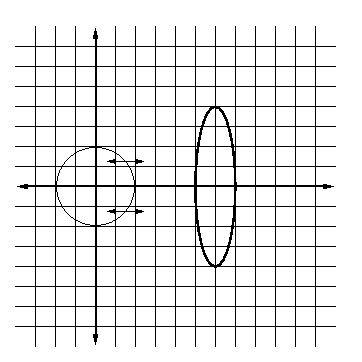Instructions:Answer all the following questions in the space provided. Simplify all answers.
- Which conic section is defined by the following standard equations.
a) x2 + y2 = 49 ______________________
b) (x - 4)2/25 - (y + 2)2/20 = 1 ______________________
c) x = 10(y - 8)2 ______________________
d) x2/4 + (y - 5)2/16 = 1 ______________________
- Draw pictures that shows the three different ways that a line and a circle can intersect.
- Two quadratic equations can intersect 0, 1, 2, 3 or 4 times. Draw a picture that illustrates:
|
a) A hyperbola and circle intersecting once |
b) A parabola and an ellipse intersecting twice. |
|
|
| c) A parabola and circle intersecting at 3 points |
d) A circle and an ellipse intersecting at 4 points. |
|
|
- The following questions involve the equation 8x2 + 5y2 - 64x + 20y + 108 = 0.
a) Inspect the coefficients in the equation. State which conic section this equation might represent and explain your answer.
b) Rewrite the equation in standard form to show that your answer in the previous question is correct.
- The following questions involve the equation x2 + 12x - 3y + 39 = 0.
a) Inspect the coefficients in the equation. State which conic section this equation might represent and explain your answer.
b) Rewrite the equation in standard form to show that your answer in the previous question is correct.
- A linear-quadratic system of equation consists of the equations:
y + (3/4)x = 0 and
x2 + y2 - 25 = 0.
a) Sketch the graph of the system on the provided graph
paper.

b) From the graph, estimate the solution of the system.
c) Use algebra to find the exact solutions to the system.
d) Show how to check your answer in part (c) by substituting the solutions back into the original equations.
- The equations x2 + 4y2 - 36 = 0 and x - 2y - 6 = 0 define a linear-quadratic system of equations.
a) Sketch the graph of the system on the provided graph paper.

b) From the graph, estimate the solution of the system.
c) Use algebra to find the exact solutions to the system.
d) Show how to check your answer in part (c) by substituting the solutions back into the original equations.
- A quadratic-quadratic system of equations consists of the following:
4x2 - y2 - 7 = 0 and
2x2 + 5y2 - 9 = 0.
a) Sketch the graph of the system on the provided graph paper.

b) From the graph, estimate the solution of the system.
c) Use algebra to find the exact solutions to the system.
d) Show how to check your answer in part (c) by substituting the solutions back into the original equations.
- The equations x2 + y2 - 12 = 0 and x2 - 4y = 0 define a quadratic-quadratic system of equations.
a) Sketch the graph of the system on the provided graph paper.

b) From the graph, estimate the solution of the system.
c) Use algebra to find the exact solutions to the system.
d) Show how to check your answer in part (c) by substituting the solutions back into the original equations.
- In Figure 1, a circle is translated over the fixed graph of an ellipse by varying the value of h in the circle equation (x - h)2 + y2 = 4.
For what positive values of h does the circle intersect the ellipse at:
Figure 1

a) one point? ______________________
b) two points? ______________________
c) three points? ______________________
d) four points? ______________________
e) no points? ______________________
|




